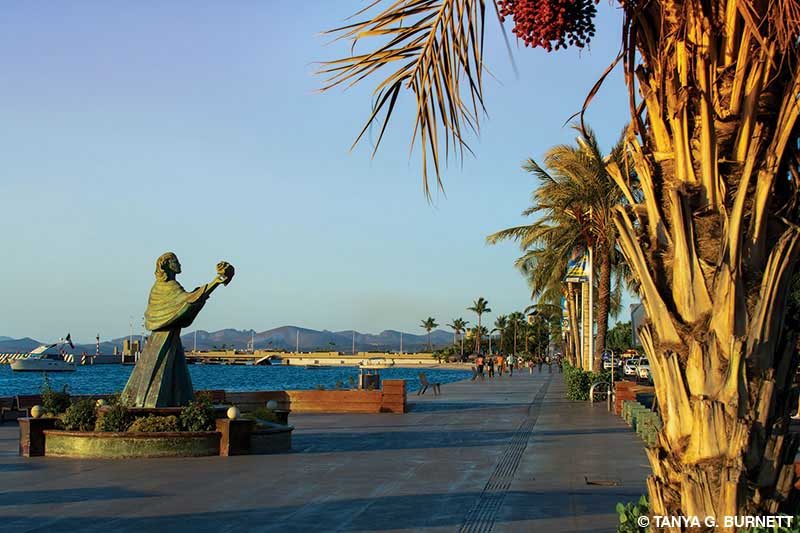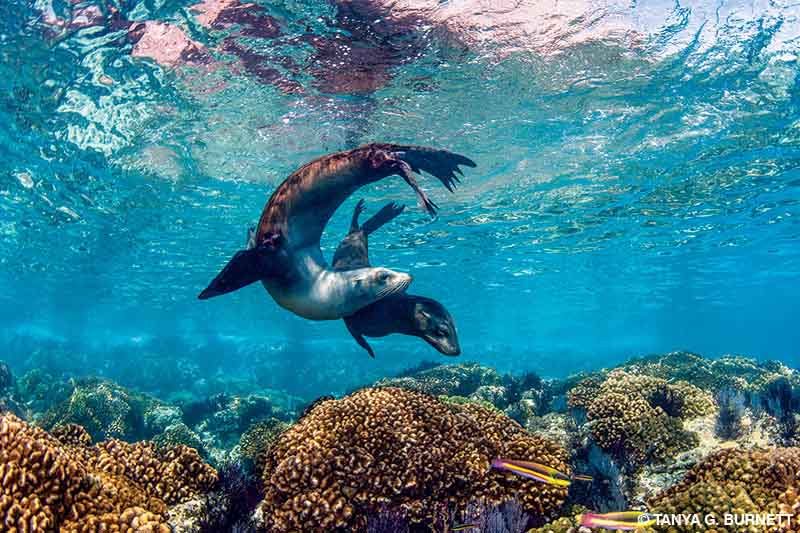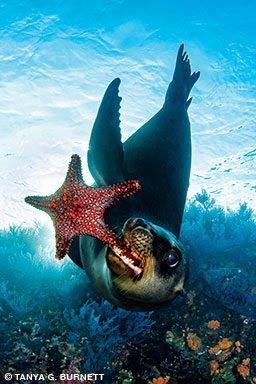Connected to the sea
An enchanting array of enormous sea-inspired bronze statues dwarf me as I walk along the waterfront area known as the Malecón. There are voluptuous mermaids, leaping dolphins, a conch shell the size of a car, a humpback whale, hammerheads, fishers in action, a whale shark and a lanky Jacques Cousteau.
La Paz, on Mexico’s Baja California Peninsula, has always been connected to the sea, from its indigenous pre-Columbian people and a history of sea explorers, pearl divers and fishers to a modern destination attracting ocean-inspired tourists to interact with the abundant marine treasures of this region. The sweeping views of the ocean, the cry of seabirds and the plentiful masts and rigging of sailboats in the harbor all chorus the same message: If you seek adventure on and in the water, you have arrived.

Mexico opening to tourists has helped many travel-oriented businesses during the COVID-19 pandemic, but the government has implemented many requirements: Visitors may be subject to health screenings including a temperature check, masks are mandatory everywhere, and you must have a temperature check and sanitize your hands and shoes before entering any structure. The pungent salt air and the aromas of street-vendor food, seaweed and the earthy musk of sea lions penetrate the fabric of my mask and make me feel alive and thrilled to be traveling again.
On the Water
For my first morning outing, our panga captain heads north toward Isla Espíritu Santo, a distant, mountainous island that marks the archipelago of the same name. The rugged series of islands, islets and coastal areas in the Gulf of California became a UNESCO World Heritage Site in 2005 and a protected national park in 2007.
As we approach the enormous volcanic formations, undulating coves and deserted beaches take shape in contrast to the indigo waters. Frigate birds soar overhead against a clear turquoise sky, while swells lap against the ancient rocks. In the distance, I spot a pod of dolphins whose dorsal fins punctuate the surface. I glance hopefully toward the captain to see if he is inclined to make a detour. He recognizes my look but shakes his head with a gentle smile. I smile back and patiently wait for more wonders to unfold.

Los Islotes

Frolicking with California sea lions is a signature marine mammal experience in La Paz. Evident by the smells and sounds as you approach from downwind, the Los Islotes colony of roughly 400 animals is just north of Isla Partida on two rock formations split by a narrow channel. Our guide briefs us on our dives and how to interact with the playful pups, who often use their mouths for exploring objects and divers. On the first dive we follow our guide through a stunning underwater arch kissed by rays of sunlight refracting down the walls and igniting orange cup coral with an electric tangerine glow. Large boulders line the bottom at 45 feet, while overhead sea lion pups are silhouetted in the cavern-like arch as they gulp air from the surface.
Like a well-choreographed ballet, the pups begin serpentine maneuvers around each other in dramatic freedives, pausing in front of our masks as if confirming our species. They show us they too can blow bubbles as they rocket to the surface through their own bubble burst. The pups grab shells and sea stars and gracefully play with anything that looks interesting. One team distracts us with a full cuteness assault from the front while another sneaks in from the back to grab fins, regulator hoses and the occasional camera housing knob. Our underwater belly laughs at their mischievous coordination drain air from our tanks.
From these clear, coral-filled shallows and boulders, we move on to other areas where females slumber on the sandy bottom. Each side of Los Islotes offers a different sea lion habitat.
After three dives with sea lions, we head to the Fang Mingwreck for our last dive of the day. The wreck is on the southwest side of Isla Espíritu Santo and rests at about 70 feet. As I begin to circumnavigate the deck at about 45 feet, I notice green sea turtles scattered about and often tucked into sheltered nooks and crannies. The wreck has nice penetration opportunities, but for me the star of the show was the lazy turtle aggregation.

On another day we dive off the south end of Isla Espíritu Santo in the San Lorenzo Channel on the rocky Swanee Reef. You can easily see the main rock that rests 6 feet below the surface. As we descend past a hearty layer of cauliflower coral covering the sides of the rock pinnacle, we notice a myriad of small tropical fish hiding in its knobby branches. Coral hawkfish, small starry groupers, juvenile king angelfish, Cortez angelfish and an occasional octopus are in residence. Out in the sand garden, eels sway in the current like a field of wheat, while schools of Mexican goatfishes parade across the sand, exploring with their barbels. The maximum depth of 45 feet gave us ample bottom time to explore the entire reef and see the surprising variety of corals, ranging from small sea fans to encrusting hard coral.
Panduan Salvatierra wreck lies just beyond Swanee Reef on a sandy bottom at roughly 60 feet. The wreck of this cargo ferry, which hit the reef and sank in 1976, is festooned with marine growth and home to large schools of triggerfish, king angelfish, moray eels and turtles. Yellow snapper and silver grunts find sanctuary among the yellow and black soft corals hanging inside the cabins. When the current runs hard here, the structure’s outline comes alive with fish hugging the wreck and swimming to hold their positions.

Exploring Topside
An early El Norte wind comes through the area during my visit, closing all the ports. Several guides tell me about the must-see Balandra Beach, which has restricted access due to the pandemic, but I arrive after the limited number of entries to the park are allotted. I don my best disappointed-tourist expression (which is difficult behind a mask) and ask the ranger in my broken Spanish if there is another option. With a conspiratorial wink, he hints that there might be a trail up the road at Tecolote Beach that offers an impressive view of Balandra.
A half mile down the road I ask some locals about the trail to see Balandra, and they point me toward a rugged-looking foothill, letting me know I would need good shoes for the significant hike. I look down at my beach-ready flip-flops and think to myself, “Nothing ventured, nothing gained,” as I gingerly step over the loose rocks and shifting gravel.
Eventually a stiff, salty breeze meets me at the edge of a cliff that provides a breathtaking vista — a beautiful crescent of deserted beach and a second arc showing Balandra a bit further away. I scramble down the slope to enjoy my reward of a huge private beach sheltered from the wind and kissed with water that shimmers with iridescent shades of aquamarine more reminiscent of the Caribbean than the Pacific.

Visiting the Queens

The wind eventually gives way to a gentle breeze. Our captain takes advantage of the calm seas to head to the distant La Reina dan La Reinita (Queen and Little Queen). As we approach, we can see the ever-present sea lions sunning on the rocks as our guide directs us to the calm lee side of the island. We jump in, and I give a small gasp at visibility of more than 100 feet, quite unlike most of my Eastern Pacific diving. A large turtle departs as we make our way to the remains of a broken wreck, while another one circles the huge propeller and glides to a section gilded in brilliant orange cup coral. A shy giant hawkfish sits camouflaged among the coral, its patterns akin to encrusted steel. A zebra moray makes a fleeting but striking appearance. A few fin kicks away a large school of blacknosed butterflyfish surrounds a nearby rock.
Our guide signals for us to pause. We crane our neoprene-clad necks, hoping this cleaning-station behavior means that something big — perhaps a manta or shark — will glide in, but such a visit isn’t on the schedule for this dive. As we round a corner, a curious sea lion accompanies us. No matter how many you see, they never get old.
The current gently pushes us toward a canyon of swaying sea fans awash in microbubbles. This carbonated effect from the wave action on the surface adorns everything in a sunlit sparkle. A large school of blue-lined snapper along with barracuda and distant milkfish add motion to the fairyland effect. We spend our safety stop marveling at the smaller life among the eggplant-purple and white sea fans, making the most of the stunning visibility.
La Reinita is a series of large rocks that break the surface and then tumble down to more than 80 feet. As I slowly descend, it occurs to me that Little Queen could also refer to the many little residents. I fin through schools of chromis and sergeant majors and play hide-and-seek with a coy Mexican hogfish. I occasionally see an interesting bright nudibranch, and a variety of blennies pop out of little crevices. At a rubble sand area in 45 feet, we slow to watch the jawfish community retreat into holes at our approach. Large Panamic cushion stars line the bottom, and I see the red and blue flash of colorful bluebanded gobies darting in and out of sight along the edges of the large rock outcroppings.

Whale Sharks
La Paz Bay has juvenile whale shark aggregations between October and May, and only permitted operators can enter the protected area. The government did not issue any permits during our visit, so we could not experience this amazing event. Sometimes you can spot whale sharks elsewhere around La Paz during the fall and spring plankton blooms.
Cabo Pulmo
You can arrange to visit and dive the Cabo Pulmo National Marine Park, which is a two-and-a-half-hour drive south of La Paz. In 1995 the Mexican government designated more than 27 square miles of reef as a marine protected area to protect it from overfishing. With no anchors or fishing lines, the reef started to grow back and the biomass of sea life returned. After more than 20 years as a no-take zone, Cabo Pulmo is now a wonderful success story and a promising sign of what may be accomplished in other regions.
Strict diver limitations are in place to maintain and protect the reef. Boat captains must call ahead to reserve time at a site. Only two dive boats are allowed at the same site at once, and dives are limited to 45 minutes. Our guide is adamant that we visit El Vencedor, a small tuna trawler that has been underwater for more than 35 years. The park officials clear us to dive it at 1 p.m., so we kill time by watching seabirds skim over the placid surface until the captain sees the previous divers surface and we are allowed to jump in.

As we dive toward the sandy bottom at 45 feet, we are lucky to have dropped in near a huge school of Pacific spadefish swimming gently in the current. I do my best to fin gently in their midst before drifting toward the wreck. The El Vencedor has no discernable structure and appears to be an amorphous mass of fish. As we get closer, the schools slowly part like a veil and reveal the scattered wreckage. We spend the entire dive navigating pieces of wreckage accompanied by the ebb and flow of the communal school of reef fish with their colors and patterns encircling us in all directions. My dive highlight is a single striking golden grouper — a leopard grouper that has morphed into a brilliant gold color — well-fed and on the prowl for unsuspecting meal possibilities. Bull sharks are regular visitors to this cleaning-station site, but I didn’t see any on this trip.
On our final dive in Cabo Pulmo, I hope to see the enormous school of bigeye jacks that resides in the area. The captain tells me, “We first must find the school!” So we set off under the bright sunlight, armed with polarized sunglasses and heeding the signature clues the captain gave us. We scan the horizon like mariners in the days of old, looking not for the blow of whales but for something far more subtle.
The captain and guides excitedly signal as we approach a distinctive dark shade of indigo in the water, and the air seems electric as we notice the fish scent. We gear up, and the captain positions us with the expertise of someone who has spent decades on the water. The strong current could make this dive a lot of work, depending on the fish behavior, but that only enhances our excitement. We roll in but see nothing. For a moment, my heart sinks at the thought of another near miss.

The guide signals us to follow, and after a few fin kicks we see a massive top-to-bottom dark shadow. Then the jacks are on us by the hundreds. I have often dived with schooling jacks around the world, and this is the biggest group I have ever seen. It is hard to describe the feeling of sheer amazement when immense marine life so completely dwarfs you that you become insignificant. Being gobsmacked probably comes close. We stay with the school long enough to be fully encircled while the fish shift in response to some unseen conductor — circling left, circling right, spiraling, darting diagonally — sometimes in unison, other times as rotating streams in opposite directions. During our ascent, the immense school makes one last amazing turn, and the light perfectly hits them as the school leaders head off into the current. We are exhausted. We are thrilled. And when the regulators come out of our mouths, so do all the exclamations at once. This encounter is what we were hoping for.
With its wildlife, people, landscapes and food, La Paz left me enchanted. I did not get everything on my wish list — traveling divers rarely do — but I can’t wait to return and continue exploring the treasures here. Perhaps next time I will get to see all the beautiful smiles hidden behind face masks on the many people who worked hard to make my experience unforgettable.
Cara Menyelam
Sampai di sana: The Manuel Márquez de León International Airport (LAP) in La Paz receives flights from the U.S. via Mexico City, Guadalajara or Los Angeles. Flights from other continents connect in Mexico City. Once on the ground, you can take a quick shuttle ride to the dive resorts. Many visitors choose to fly into Los Cabos International Airport (SJD), which offers more flight options, and then take a 2.5-hour shuttle ride north to La Paz. You can also rent a car and drive a beautiful route for glimpses of the desert mountains, the Pacific Ocean and the Gulf of California.
Kondisi: Diving is available year-round, either from land or by liveaboard. La Paz offers land-based resort accommodations to suit all budgets, with most diving occurring from small but comfortable pangas that provide an easy back-roll entry. Liveaboards start in La Paz or Cabo, and operators offer unique itineraries to provide the best diving for the region. When diving in a marine park, liveaboard operators must use a land-based dive operator to conduct the dives, but this arrangement is seamless and doesn’t restrict the liveaboard experience.
Do some research to determine the best time of year for what you hope to experience. The conditions and marine life vary throughout the year, and some marine life encounters may be restricted. The water temperature in the Gulf of California changes substantially over the year. A 3 mm wetsuit is recommended from June to November, when the water temperature ranges from 78°F to 86°F. Visibility is generally excellent except during plankton blooms. A 5 mm or 7 mm wetsuit is more appropriate from December through May, when the average water temperature is 70°F.
Jelajahi Lebih Lanjut
Watch the video below for a virtual dive at La Paz, and then see more of Tanya Burnett’s photography in a galeri foto bonus.
© Penyelam Siaga — Q1 2021